Yonaguni
Yonaguni (Japanese: 与那国島, Hepburn: Yonaguni-jima, Yonaguni romanization: Dunan-chima, older Juni-shima,[2] Yaeyama romanization: Yunoon-zïma, Okinawan romanization: Yunaguni-jima), one of the Yaeyama Islands, is the westernmost inhabited island of Japan, lying 108 kilometers (67 mi) from the east coast of Taiwan, between the East China Sea and the Pacific Ocean proper. The island is administered as the town of Yonaguni, Yaeyama Gun, Okinawa, and there are three settlements: Sonai, Kubura, and Higawa.
| Native name: | |
|---|---|
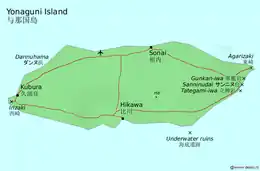 Map of Yonaguni Island | |
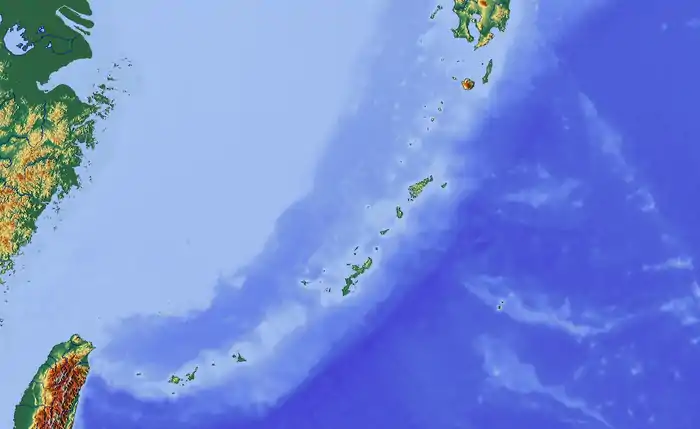 Yonaguni Location  Yonaguni Location in Japan | |
| Geography | |
| Location | Pacific Ocean East China Sea |
| Coordinates | 24°27′20″N 122°59′20″E |
| Archipelago | Yaeyama Islands |
| Area | 28.88 km2 (11.15 sq mi) |
| Highest elevation | 471 ft (143.6 m) |
| Highest point | Mount Urabu |
| Administration | |
| Region | Kyushu |
| Prefecture | Okinawa Prefecture |
| Town | Yonaguni, Okinawa |
| Demographics | |
| Population | 1,684 (2009) |
| Pop. density | 58.2/km2 (150.7/sq mi) |
| Ethnic groups | Ryukyuan, Japanese |
History
Early human migration from Taiwan to Yonaguni island has long been the subject of scholarly debate. In 2019, a team of Japanese and Taiwanese researchers succeeded in completing the two-day journey from Cape Wushibi in Taitung County to Yonaguni island along the Kuroshio current in a dugout canoe based on technology and materials from 30,000 years ago.[3][4] Otherwise, the early history of Yonaguni remains vague. The first written record that ever mentions the island is a 1477 Korean document (Chosen Hyōryūmin no Yaeyama kenbunroku), an account of several fishermen from the current Jeju Province who drifted there.
A legendary female leader, San’ai Isoba, is said to have been the ruler of Yonaguni at around the end of the fifteenth century. She is described as a female who possessed superhuman powers that allowed her to protect her people from foreign attacks multiple times, including when the island was attacked by Miyako, another Yaeyama island nearby. Rituals are still held once a year to worship this mythical figure.[5]
In the 15th century, the island was incorporated into the Ryūkyū Kingdom.[6] By 1879, the island was formally annexed by imperial Japan.
Until the early 20th century, Yonaguni was part of the larger Yaeyama Magiri (village after 1907), which included the neighboring Yaeyama Islands. In 1948, it became an independent village. From 1945 to 1972, it was occupied by the United States and was then returned to Japan to form a part of Okinawa Prefecture.
On 4 May 1998, a part of the island was destroyed by a submarine earthquake.
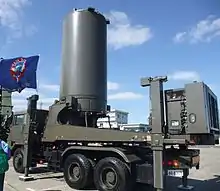
As a result of increased tensions between Japan, China, and Taiwan over the disputed sovereignty of the Japanese-controlled uninhabited Senkaku/Diaoyu/Tiaoyutai Islands which are located roughly 80 nautical miles north-northeast of Yonaguni Island, Japan began construction in 2014 of a coastal monitoring/early warning station with radar and other sensors on Yonaguni to counter a perceived threat from Chinese forces.[7][8] The initial planned complement of 150 troops include personnel stationed at a physically separate garrison camp located on the outskirts of Yonaguni town.[9] The station's radar became active on 28 March 2016.[10] Separately, a joint (GSDF/ASDF) "mobile aircraft control & warning squadron" is planned to be formed and co-located at the station.
Mythical and cultural references
As the westernmost inhabited island of Japan, Yonaguni has also been constantly associated with the myth of the island of women (Nyōgo no Shima) since the Edo period. As suggested by the name, the island of women is an island where there are only women born and living to support each other. Being a trope frequently used in Edo literary works, it not only appears at the end of The Life of an Amorous Man (好色一代男 Kōshoku Ichidai Otoko, 1682), but also dominates the second part of the five-section Strange Tales of the Crescent Moon (椿説弓張月 Chinsetsu Yumiharizuki, 1807–1811). While the whole second part of the story is about the protagonist Tametomo's time spent on the island of women, which is the westernmost island of Japan according to the tale, the map provided at the beginning of the third section clearly marks the island as 'Yonaguni', assuming the association between the mythical women island and Yonaguni.[11]
During the Taisho period, the Yaeyama islands including Yonaguni gradually came to be explored by people traveling from Japan, as there were ships from Osaka to Yonaguni once a year[12] that introduced outsiders to the islands, who brought their knowledge about Yonaguni back to Japan through many ways, such as writing.
Out of all these early records about Yonaguni, one of the earliest and most influential writings was An expedition to the Southern Islands (Nantō tanken) by Sasamori Gisuke. In Sasamori's research of Yonaguni, the island was notable due to its women: "Women on the island have white skin, and are attentive and thoughtful. It takes only a few pennies for someone who enjoys accompaniment of beautiful women to have one of them in attendance during his stay provide drinks and serve him all night."[13] The statement was confirmed by a later published collection of essays. A folk culture scholar, Motoyama Keisen, asserts that "Yonaguni is the island of women", and continues to quote and agree with Sasamori's account of Yonaguni women, saying that "Surely this was true in 1893, when the author went on his expedition there."[14]
However, a counter-statement is found in a collection of some comical essays by a Taishō novelist and script writer, Murakami Namiroku, in his Collection of Satire Essays (Hiniku Bunshu), and gives a more detailed view of the circumstances of Yonaguni women. One of the essays is titled "Yonaguni" and focuses on the same topic, claiming that "once a man steps on the island, no matter how strong he is, the man would be attacked by women coming from all directions, and hardly ever there could be men who could safely withdraw from there". Furthermore, he describes Yonaguni as an island where, although there are almost only women, for reproductive purposes, there are also a few men: as many as around one-tenth of the women. Curiously, there are only female newborns. Serving as reproductive tools for the women, men are rarely able to live long. Murakami expresses his worries as well at the end, as the women here are all naturally beautiful and potentially they would attract those driven by sexual desire to explore "the hidden paradise".[15]
Nevertheless, these introductory essays aiming to bring an exotic taste are less specific than a quite comprehensive travel log by Yanagita Kunio, who was inspired by Sasamori's work and finally did his own research, An Account of the South Sea (Kainan shōki), published in 1925. A long essay from the collection is titled and devoted to "Yonaguni Women". He provides a detailed written record of their customs and daily life, and writes about how they are busy farming, cooking, and taking care of the kids, with two photographs attached, wearing clothes not so much different from the rest of Japan.[16]
Yonaguni islanders traditionally believed that their island had once been ruled by a goddess named Miruku, who brought fertility to the land. She was ousted by a god named Saku after a flower-growing contest for control over the island, in which Saku stole her flower while she slept. Miruku vanished, and the island's primeval prosperity sank into poverty once she left. The islanders thus held rituals in honor of the goddess in the hope that she might one day return. As late as the 1980s, the highlight of the Yonaguni harvest festival was a procession involving a person in a Miruku mask reenacting the goddess. A nearly identical myth is widespread in Korea.[17]
Geography
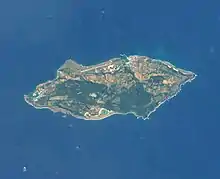
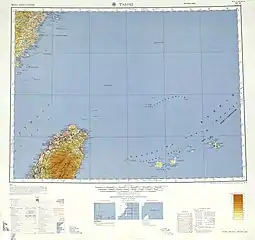
The island has an area of 28.88 km2 (11.15 sq mi), a population around 1,700, an annual mean air temperature of 23.9 °C (75.0 °F), and annual precipitation of 3,000 millimeters (120 in).
Yonaguni, more specifically Cape Irizaki 24°26′58″N 122°56′01″E at the western tip of the island, is the westernmost point of Japan. The island is situated in the middle of the Yonaguni Depression, a relatively deep gap in the Ryukyu arc, where the warm Kuroshio Current enters the East China Sea from the Pacific Ocean.[18]
According to Japanese anthropologist Yousuke Kaifu, the island of Yonaguni can be seen with the naked eye from Taroko Mountain in Taiwan under good weather conditions.[19]
Notable features
Yonaguni is known in Japan for the hanazake, a 120-proof rice-based distilled beverage (awamori) produced only on the island.
The island is also the only natural habitat of a distinctive horse breed, the Yonaguni horse.
Yonaguni's densely forested areas provide a suitable habitat for the Ryukyu atlas moth (A. a. ryukyuensis).
Yonaguni is a popular attraction for divers because of the large numbers of hammerhead sharks that gather in the surrounding waters during winter.
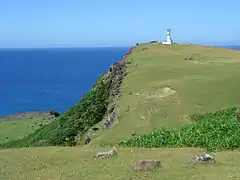 Agarizaki Lighthouse, Yonaguni island
Agarizaki Lighthouse, Yonaguni island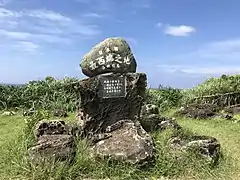 Monument for Japan's westernmost point, Cape Irizaki
Monument for Japan's westernmost point, Cape Irizaki Sunset at Yonaguni, Ryukyu Islands. The last sunset in Japan.
Sunset at Yonaguni, Ryukyu Islands. The last sunset in Japan.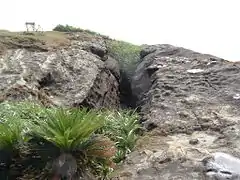 Kubura Bari
Kubura Bari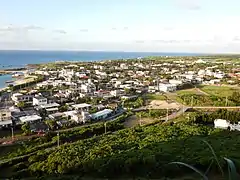 Sonai from Tindabana
Sonai from Tindabana
Yonaguni Monument
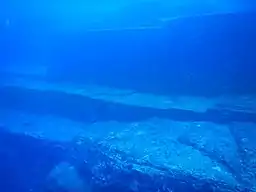
In 1986, local divers discovered a striking underwater rock formation off the southernmost point of the island. The formation, known popularly as the Yonaguni Monument, has staircase-like terraces with flat sides and sharp corners. Masaaki Kimura, a professor from Okinawa, believes it is an artificial (or artificially modified) structure; however, the majority of academic society regard the rock formation as a natural geologic structure.[20]
Irizaki
Cape Irizaki is the westernmost point of Japan and the place to see the final sunset in Japan.
Agarizaki
Cape Agarizaki is the easternmost cape of Yonaguni. Tourists come here to view the sunrise and to observe scenic views of the ocean at the 100-meter-high (330 ft) cape. Other attractions include the lighthouse and Yonaguni horse.
South-east coast
- Gunkan-iwa is a rock formation near the shore that looks like a battleship
- Tachigami-iwa (Tatigami-iwa) is a single big rock outstanding offshore
- Sanninudai is a place with step-like slate rock terraces, and offers a viewing point for Gunkan-iwa
- Jinmen-iwa is a big rock in the forest that resembles a human face
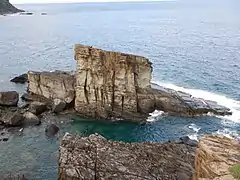 Warship rock (Gunkan-iwa)
Warship rock (Gunkan-iwa)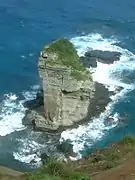 Tachigami rock
Tachigami rock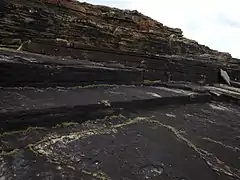 Sanninudai
Sanninudai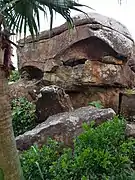 Jinmen-iwa
Jinmen-iwa
Transportation
Yonaguni Airport serves Yonaguni island.
Television
Yonaguni was the filming location for Fuji TV's drama series Dr. Kotō Shinryōjo (Dr.コトー診療所 / Dr. Koto's Clinic), which aired between 2003 and 2006. A fictional Chinese naval incursion into Yonaguni's territorial waters and the ensuing military standoff was a plot point of the second season of House of Cards (S2E10).
Climate
Yonaguni has a tropical rainforest climate (Köppen climate classification Af). The average yearly temperature is 23.8 °C (74.8 °F), and the average monthly temperature ranges from 18.4 °C (65.1 °F) in January to 28.8 °C (83.8 °F) in July. September is the wettest month while July is the driest.
| Climate data for Yonaguni | |||||||||||||
|---|---|---|---|---|---|---|---|---|---|---|---|---|---|
| Month | Jan | Feb | Mar | Apr | May | Jun | Jul | Aug | Sep | Oct | Nov | Dec | Year |
| Record high °C (°F) | 27.5 (81.5) |
27.7 (81.9) |
29.0 (84.2) |
30.4 (86.7) |
33.1 (91.6) |
33.4 (92.1) |
35.5 (95.9) |
34.6 (94.3) |
34.4 (93.9) |
33.9 (93.0) |
30.2 (86.4) |
28.0 (82.4) |
35.5 (95.9) |
| Average high °C (°F) | 20.5 (68.9) |
21.0 (69.8) |
22.8 (73.0) |
25.2 (77.4) |
27.7 (81.9) |
29.8 (85.6) |
31.4 (88.5) |
31.2 (88.2) |
29.8 (85.6) |
27.6 (81.7) |
24.9 (76.8) |
21.9 (71.4) |
26.1 (79.1) |
| Daily mean °C (°F) | 18.4 (65.1) |
18.8 (65.8) |
20.4 (68.7) |
22.9 (73.2) |
25.3 (77.5) |
27.5 (81.5) |
28.8 (83.8) |
28.5 (83.3) |
27.3 (81.1) |
25.4 (77.7) |
22.8 (73.0) |
19.8 (67.6) |
23.8 (74.9) |
| Average low °C (°F) | 16.4 (61.5) |
16.8 (62.2) |
18.3 (64.9) |
20.8 (69.4) |
23.2 (73.8) |
25.6 (78.1) |
26.6 (79.9) |
26.2 (79.2) |
25.1 (77.2) |
23.5 (74.3) |
20.9 (69.6) |
17.9 (64.2) |
21.8 (71.2) |
| Record low °C (°F) | 7.7 (45.9) |
8.4 (47.1) |
9.0 (48.2) |
12.1 (53.8) |
15.0 (59.0) |
17.6 (63.7) |
21.9 (71.4) |
21.7 (71.1) |
18.2 (64.8) |
16.2 (61.2) |
11.4 (52.5) |
9.1 (48.4) |
7.7 (45.9) |
| Average precipitation mm (inches) | 198.8 (7.83) |
157.9 (6.22) |
152.1 (5.99) |
173.3 (6.82) |
207.4 (8.17) |
164.0 (6.46) |
138.5 (5.45) |
212.5 (8.37) |
293.2 (11.54) |
227.7 (8.96) |
248.3 (9.78) |
179.7 (7.07) |
2,353.4 (92.66) |
| Average relative humidity (%) | 74 | 77 | 78 | 79 | 81 | 83 | 80 | 81 | 79 | 75 | 74 | 72 | 78 |
| Mean monthly sunshine hours | 55.7 | 57.2 | 82.4 | 99.5 | 140.1 | 182.1 | 258.9 | 229.3 | 182.5 | 136.9 | 85.9 | 64.7 | 1,575.2 |
| Source 1: JMA (1981-2010) [21] | |||||||||||||
| Source 2: http://www.data.jma.go.jp | |||||||||||||
References
- Alexander Vovin (2010). Korea-Japonica: A Re-Evaluation of a Common Genetic Origin. University of Hawaii Press. p. 43. ISBN 978-0-8248-3278-0.
- Vovin 2010, pp. 43–44.
- "Team successfully replicates imagined ancient sea migration from Taiwan to Okinawa". japantimes.co.jp. The Japan Times. 9 July 2019. Retrieved 1 June 2020.
- "Crew sets out in canoe to test theory ancient Taiwanese migrated to Japan". taiwannews.com.tw/. Taiwan News. 8 July 2019. Retrieved 1 June 2020.
- Tranter, Nicolas (2012). The languages of Japan and Korea. New York: Routledge. p. 412. ISBN 9781136446580.
- Kerr, George H. (2000). Okinawa: the History of an Island People. (revised ed.) Boston: Tuttle Publishing.
- Tiezzi, Shannon (18 April 2014). "Japan to Station Troops on Yonaguni, Near Disputed Islands". thediplomat.com. The Diplomat. Retrieved 18 April 2014.
- "Japan wary of China military threat." Archived June 25, 2008, at the Wayback Machine Al Jazeera, 17 December 2010.
- "Yonaguni votes in favor of GSDF deployment on island". the-japan-news.com. The Yomiuri Shimbun. 23 February 2015. Retrieved 23 February 2015.
- "Japan opens radar station close to disputed isles, drawing angry China response". reuters.com. Reuters News Service. 28 March 2016. Retrieved 29 March 2016.
- Takizawa, Bakin (1958). Chinsetsu yumiharizuki, Vol 60 Nihon koten bungaku taikei (日本古典文学大系 60 椿説弓張月 上). Tokyo: Iwanami Shoten. p. 448.
- Satō, Sōnosuke (1923). Eye of the Storm: A Collection of Poems on Ocean (Gufū no me kaiyō shishū 颶風の眼 海洋詩集). Tokyo: Arusu. p. 124.
- Sasamori, Gisuke (1894). An expedition to the Southern Islands (Nantō tanken 南島探験). Self-pub.
- Motoyama, Keisen (1925). A Taste of the Southern Islands (Nantō jōshu 南島情趣). Tokyo: Shūeikaku. p. 160.
- Murakami, Namiroku (1919). A Collection of Satire Essays (Hiniku bunshu 皮肉文集). Tokyo: Kōyō. pp. 320–323.
- Yanagita, Kunio (1925). An Account of the South Sea (Kainan shōki 海南小記). Tokyo: Sōgensha. pp. 179–201.
- Waida, Manabu (1991). "The Flower Contest between Two Divine Rivals. A Study in Central and East Asian Mythology". Anthropos. 86 (1/3): 90–92. ISSN 0257-9774. JSTOR 40462392.
- Andres, M.; Wimbush, M.; Park, J.-H.; Chang, K.-I.; Lim, B.-H.; Watts, D. R.; Ichikawa, H.; Teague, W. J. (10 May 2008). "Observations of Kuroshio flow variations in the East China Sea". Journal of Geophysical Research. 113 (C5): C05013. doi:10.1029/2007JC004200. ISSN 0148-0227.
- "Japanese may be Taiwanese migrants". taipeitimes.com. 13 July 2019. Retrieved 1 June 2020.
- "Yonaguni, Japan". New Scientist (2736). 25 November 2009. Retrieved 6 July 2010.
- "Yonagunijima Climate Normals 1981-2010" (in Japanese). Japan Meteorological Agency. Retrieved 5 February 2014.
External links
 Media related to Yonagunijima at Wikimedia Commons
Media related to Yonagunijima at Wikimedia Commons Yonaguni travel guide from Wikivoyage
Yonaguni travel guide from Wikivoyage